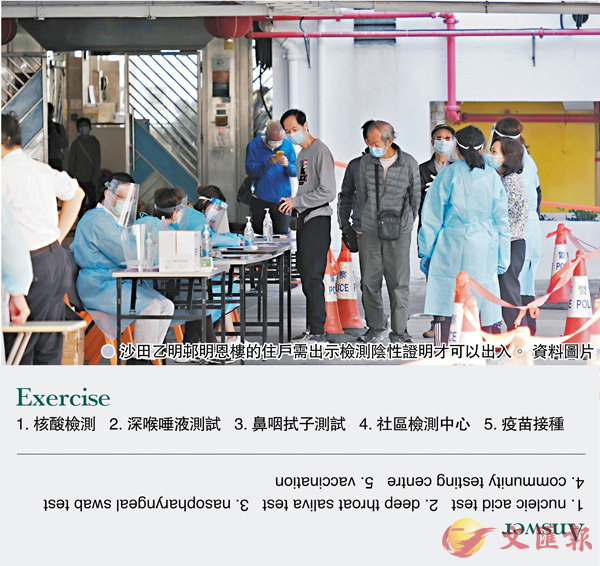
原文
政府於2020年12月24日首次進行強制檢測的執法行動,要求沙田乙明邨明恩樓的住戶出示檢測陰性證明才可以出入。這次行動展現政府嚴格落實強制檢測令,以達至社區「清零」為目標,方向正確,為本港實施全民檢測和禁足令積累經驗,提升抗疫能力。政府應通過此次強檢總結經驗,完善落實行動,減少對市民的影響,推動全港同心抗疫。
沙田乙明邨明恩樓在12月中爆發疫情,累計有6名居民牽涉4個單位受感染,部分人源頭不明,政府在17日至21日設置流動採樣亭,為大廈居民進行檢測。到12月24日,多個部門突擊採取執法行動,於明恩樓外拉起封鎖線,要求居民出入時展示接受病毒檢測結果電話短訊通知或相關證明,未有證明的會被口頭警告,再到附近流動檢測站檢測,有結果前必須留在家。
今次行動果斷迅速,事前未有通知居民,以免有未檢測者提早離開,是有必要的措施。更為重要的是,今次行動展現政府開展跨部門協作,以「聯防聯控」措施落實強制檢測。執行強檢令是一項系統工程,既要維持現場秩序,又要房協釐清住戶名單和上門查證,又要有衞生人員協助居民檢測,24日參與行動的部門中,就有沙田民政事務處聯同田心警署、醫療輔助隊和房協等多個部門共同合作,本港近一年抗疫工作效果未如理想,屢屢出現防疫錯漏,正因為缺乏跨部門通力合作、精準抗疫,24日的強檢執法是一個有益的探索。民政事務局局長徐英偉指出,今次行動目的是要確保所有明恩樓居民均已接受檢測,沒有漏網個案,只有這樣才可以達到小區「清零」。行動展現政府「清零」的決心,調動市民配合防疫的積極性。
借鑒內地的防疫成功經驗,哪裏發現疫情,就立即採取強而有力的措施,封區禁足,全民檢測排查,一般可以在短時間堵截疫情擴散,有效保障市民安全健康,盡快恢復正常生活秩序。本港經歷四波疫情,因為一直不採取全民檢測、封區等果斷的抗疫措施,導致疫情始終不能「斷尾」,經濟民生重啟無期,政府、企業、市民都付出巨大代價。經過24日明恩樓的強檢行動,市民更應明白長痛不如短痛的簡單道理。
24日強檢行動事出突然,居民的出行、生活難免有所不便,但大多數居民並無太大怨言,相反都同意無論是為自己好,還是社區好,居民都應理解、配合強檢行動。政府應認真總結24日強檢行動的得失,改善執行的細節安排,為今後實施社區強檢、排查形成一套可行快速的機制,截斷傳播鏈,努力清零。
( 摘錄自香港《文匯報》社評2020-12-25)
譯文
The government carried out its first enforcement action for compulsory testing on 24 December 2020 in Shatin, ordering residents of Ming Yan Lau block of Jat Min Chuen estate to produce a negative test result before they can enter and leave. This is a sign that the government is on the right path, as it demonstrates the government's resolve to strictly implement compulsory testing and to achieve the goal of zero infection in the community. The operation also enhances Hong Kong's ability to fight the pandemic, as the experience gained is an important step towards population-wide mandatory testing and comprehensive lockdown measures. The government should draw lessons from this experience to refine future operations, so that the impact on citizens' daily lives could be reduced.
Earlier in mid-December 2020, a small-scale community outbreak took place at Ming Yan Lau of Jat Min Chuen in Sha Tin. A total of six Covid-19 cases involving four apartment units were linked to the building, with some of them having an unknown source of infection. Consequently, the government set up mobile specimen collection stations at the building from 17-21 December to conduct screening on residents. On 24 December, the authorities followed up with a surprise inspection operation at Ming Yan Lau, cordoning the area temporarily and ordering residents to provide the text message or other relevant proof that shows the result of the Covid-19 test they were ordered to take earlier before they can enter or leave the premise. Those who could not provide proof received warnings and were immediately tested in a nearby site. They also had to stay home until results came back.
Out of necessity to prevent non-compliant residents from leaving early, the operation had to be swift and decisive, and Ming Yan Lau residents were not notified beforehand. But more importantly, this operation also showed that the government is now leaning towards a new approach in which multiple authorities would work together to enforce compulsory screening. Carrying out compulsory testing was no easy task. Housing Society officials had to check through its list of residents and then visit for verification. Health personnel had to carry out the tests on site. Throughout the whole operation, the authorities also had to maintain order. As an example, the Sha Tin District Office, Tin Sum Police Station, the Auxiliary Medical Service, the Hong Kong Housing Society, and other relevant departments were involved during the 24 December surprise inspection. Hong Kong's anti-pandemic effort in the past year has not been as effective as expected, with quite a few errors being identified along the way. It is precisely because the efforts of different government departments lack coordination and precision. The joint-operation on 24 December is a good start to rectify the problem. According to Caspar Tsui Ying-wai, the Secretary for Home Affairs, the goal of this operation was to ensure that all residents of Ming Yan Lau had undergone compulsory tests, and that only then can the area be eventually clear of Covid-19 infection. This demonstrated the authorities' determination in achieving zero infection, and their resolve to mobilise citizens to cooperate with anti-pandemic measures.
Learning from the successes of mainland China, swift and firm actions must be taken immediately in places where Covid-19 cases are found. By locking down the area and conducting compulsory screening, small community outbreaks could usually be stopped in a short period of time. The safety and health of citizens are better protected this way, and people can return to their normal lives sooner. Hong Kong has been battered by four waves of Covid-19 pandemic now, and the day when the pandemic ends still seems to be so far away. This is because necessary measures such as mandatory universal testing and comprehensive community lockdowns were never put in place. The government, enterprises, and citizens are all paying a heavy price as the people's livelihoods and normal economic activities cannot resume. After the operation on Ming Yan Lau on 24 December, the public should understand the simple fact that powering through a short-term pain is better than having to sustain the agony in the long-term.
The surprise inspection operation may cause some inconvenience to the residents, yet most of them did not complain too much. This is because they understand that for the good of both themselves and the community, it is better to cooperate. The government should review the 24 December inspection operation and refine the detailed implementation plans. By doing so, a feasible and smooth mechanism could be set up for future mandatory community screening, thus breaking Covid-19 transmission chains and taking a big step towards zero infection in Hong Kong.
●Jeffrey Tse

